Possibilities for Deep Renovation in Multi-Apartment Buildings in Different Economic Conditions in Europe
Abstract
1. Introduction
- High initial investment costs;
- Insecurity about energy performance after renovation and financial savings;
- Presently low and, in the long run, fluctuating prices of energy;
- Other priorities of proprietors and residents;
- Group involvement of proprietors in the decision-making processes;
- Inadequate technical skills of a suppliers and insufficient knowledge of proprietors;
- Low purchasing power in some European countries;
- Lack of know-how and successfully implemented projects.
- 9.
- By examining the above criteria in the case of the same building, in all analyzed European countries; and
- 10.
- By applying the PH standard, in order to avoid the country-specific definitions of nZEB.
2. Materials and Methods
- 11.
- Berlin, Germany;
- 12.
- Warsaw, Poland;
- 13.
- Debrecen, Hungary;
- 14.
- Belgrade, Serbia.
- 15.
- In order to comply with prescribed U-values for exterior insulation (0.12, 0.15, and 0.3 W·m−2·K−1 for cold, cool, and warm temperate climate zones, respectively [34]), the installation of mineral wool with variable thicknesses (15, 20, 25, or 30 cm) and the associated finishing facade materials were analyzed. For those variable thicknesses, the calculated U-value is ranging from 0.21 to 0.11 W·m−2·K−1;
- 16.
- In order to achieve U-values for the roof of 0.12 or 0.07 W·m−2·K−1, the installation of mineral wool thickness of either 30 or 50 cm was analyzed;
- 17.
- For the windows prescribed, the overall U-values vary from 0.65 to 1.20 (depending on the climate zone [34]), hence the installation of new windows with U-values of 0.6, 0.8, and 1 W·m−2·K−1 were analyzed.
- eeli,j,k [kWh/year]—Variable that represents the annual electricity consumption of a building with i wall insulation, j windows, and k roof insulation.
- engi,j,k [kWh/year]—Variable that represents the annual natural gas consumption of a building with i wall insulation, j windows, and k roof insulation.
- βi,j,k [-]—Binary variable. β = 1 if a i, j, k configuration is applied.
- ECS [€]—annual savings in energy costs,
- d [%]—a discount rate (for long term household energy efficiency investments; for all observed scenarios the discount rate is adopted as 3.5% [39]),
- lc [year]—a project lifecycle,
- Inv [€]—investment costs.
- CEb [€]—annual energy costs before the renovation,
- CEa [€]—annual energy costs after the renovation.
- feb [kWh]—a final energy consumption before the renovation;
- cdh [€/kWh]—costs of heating energy before the renovation;
- eeli,j,k [kWh]—electricity consumption after the renovation;
- cel [€/kWh]—costs of electricity;
- engi,j,k [kWh]—natural gas consumption after the renovation;
- cng [€/kWh]—costs of natural gas.
- hpp [€]—costs of p heat pump technology;
- ihp [€]—costs of heat pump installation (depends on unit labor costs in different countries).
- ciwi [€/m2]—costs of wall insulation material I;
- Awall [m2]—a wall area;
- iwall [€]—wall insulation installation labor costs (depend on unit labor costs in countries).
- cirk [€/m2]—costs of roof insulation material k;
- Aroof [m2]—a roof area;
- iroof [€]—roof insulation installation labor costs (depend on unit labor costs in some countries).
- cwj [€/m2]—costs of windows with thermal transmittance j;
- Aw [m2]—a windows area;
- iw [€]—installation of window labor costs (depending on unit labor costs in the countries).
- Anet [m2]—a net living space.
3. Results and Discussion
3.1. Results of Energy plus Modeling
3.2. Results of MINLP Optimisation
- 18.
- For Germany: 20-0.6-30;
- 19.
- For Poland: 20-0.6-30;
- 20.
- For Hungary: 20-0.6-30;
- 21.
- and for Serbia: 15-0.8-30.
- 22.
- The optimization model proposes the same optimal scenario for the countries of Central Europe. The shared feature for all those scenarios is the installment of the windows that have the best offered characteristics, which are also the most expensive ones. This further suggests that these scenarios, including the windows, with even higher performances should be explored in the future;
- 23.
- Serbia is the only country where the highest performance windows are not recommended. Furthermore, for this country, the lowest costs of DR, i.e., the highest U-values, are suggested (Figure 7). This can be contributed to the low price of energy and low economic-related indicators.
- 24.
- For Germany, the starting CO2 tax should amount to 25 €/tCO2 and the tax should rise 10% annually or a 30% upfront subsidy combined with a CO2 tax should amount to 25 €/tCO2 and should rise by 6% annually;
- 25.
- For Poland, the starting CO2 tax should amount to 15 €/tCO2 and the tax should rise 7% per year or a 30% upfront subsidy when the CO2 tax will not be necessary to achieve cost-effectiveness in Poland’s optimal scenario;
- 26.
- For Hungary, the starting CO2 tax should amount to 25 €/tCO2 and the tax should rise 10% annually or a 30% upfront subsidy combined with a CO2 tax that should amount to 25 €/tCO2 and should rise by 8% annually;
- 27.
- For Serbia, the starting CO2 tax should amount to 25 €/tCO2 and the tax should rise 9% per year or a 30% upfront subsidy combined with a CO2 tax that should amount to 25 €/tCO2 and should rise by 8% per year.
- 28.
- The DR will not be cost-effective without the intervention of subsidies, under the expected future rise of energy prices in all observed scenarios. This conclusion is similar to the findings in [28], where it is proposed that policy innovation is necessary in order to fasten the pace of building renovations. These include the engagement of the public, and the introduction of incentives and/or tax brakes, new evaluation methods, application procedures, and innovative ways to fund renovation projects;
- 29.
- Carbon taxing, only as a measure to push projects toward cost-effectiveness, can be effective in all scenarios if the tax starts at 25 €/tCO2, and then rises at a steady pace that is (in all observed scenarios) slower than 10% per year;
- 30.
- As the DR is a labor-intensive endeavor, the different labor costs could have an enormous impact on the total costs, thus crucially impacting NPV and even overcoming some other influential factors that are considered important in such cases (e.g., the price of energy);
- 31.
- The combination of lower-than-average labor price, low price of energy, and high environmental footprint of energy could enable countries such as Poland and Serbia to secure the benefits from the carbon tax in the observed cases, even with a low carbon tax. These countries could keep the pace surprisingly well with more developed countries, but only in certain scenarios, i.e., when a replaced source of heating energy is relatively expensive. Moreover, a hidden threat in the form of a free market could undermine the only mentioned subtle comparative advantage of the Eastern European countries. Namely, the market forces attract a skilled workforce to Western Europe, jeopardizing the possibility of Eastern Europe to develop sustainably.
4. Conclusions
Author Contributions
Funding
Acknowledgments
Conflicts of Interest
References
- Eurostat Smarter, Greener, More Inclusive? Indicators to Support the Europe 2020 Strategy; EUROSTAT: Luxembourg, Germany, 2016; ISBN 9789279591471.
- Ohlsson, K.E.A.; Olofsson, T. Benchmarking the practice of validation and uncertainty analysis of building energy models. Renew. Sustain. Energy Rev. 2021, 142, 110842. [Google Scholar] [CrossRef]
- Kalamees, T.; Lupíšek, A.; Sojková, K.; Mørck, O.C.; Borodinecs, A.; Almeida, M.; Rovers, R.; Op’Tveld, P.; Kuusk, K.; Silva, S. What Kind of Heat Loss Requirements NZEB and Deep Renovation Sets for Building Envelope? In Proceedings of the CESB 2016—Central Europe towards Sustainable Building 2016: Innovations for Sustainable Future, Prague, Czech Republic, 22–24 June 2016; pp. 137–144. [Google Scholar]
- Amoruso, F.M.; Sonn, M.; Schuetze, T. Carbon-neutral building renovation potential with passive house-certified components: Applications for an exemplary apartment building in the Republic of Korea. Build. Environ. 2022, 215, 108986. [Google Scholar] [CrossRef]
- Mikola, A.; Hamburg, A.; Kuusk, K.; Kalamees, T.; Voll, H.; Kurnitski, J. The impact of the technical requirements of the renovation grant on the ventilation and indoor air quality in apartment buildings. Build. Environ. 2022, 210, 108698. [Google Scholar] [CrossRef]
- Rose, J.; Kragh, J.; Nielsen, K.F. Passive house renovation of a block of flats—Measured performance and energy signature analysis. Energy Build. 2022, 256, 111679. [Google Scholar] [CrossRef]
- Femenías, P.; Mjörnell, K.; Thuvander, L. Rethinking Deep Renovation: The Perspective of Rental Housing in Sweden. J. Clean. Prod. 2018, 195, 1457–1467. [Google Scholar] [CrossRef]
- Dotzler, C.; Botzler, S.; Kierdorf, D.; Lang, W. Methods for Optimising Energy Efficiency and Renovation Processes of Complex Public Properties. Energy Build. 2018, 164, 254–265. [Google Scholar] [CrossRef]
- Krizmane, M.; Borodinecs, A.; Dzelzitis, E. Enabling the Landscape for Deep Green Renovations. Energy Procedia 2016, 96, 404–412. [Google Scholar] [CrossRef][Green Version]
- Jradi, M.; Veje, C.; Jørgensen, B.N. Deep Energy Renovation of the Mærsk Office Building in Denmark Using a Holistic Design Approach. Energy Build. 2017, 151, 306–319. [Google Scholar] [CrossRef]
- Bonakdar, F.; Dodoo, A.; Gustavsson, L. Cost-Optimum Analysis of Building Fabric Renovation in a Swedish Multi-Story Residential Building. Energy Build. 2014, 84, 662–673. [Google Scholar] [CrossRef]
- Semprini, G.; Gulli, R.; Ferrante, A. Deep Regeneration vs Shallow Renovation to Achieve Nearly Zero Energy in Existing Buildings: Energy Saving and Economic Impact of Design Solutions in the Housing Stock of Bologna. Energy Build. 2017, 156, 327–342. [Google Scholar] [CrossRef]
- Cholewa, T.; Balaras, C.A.; Nižetić, S.; Siuta-Olcha, A. On Calculated and Actual Energy Savings from Thermal Building Renovations—Long Term Field Evaluation of Multifamily Buildings. Energy Build. 2020, 223, 110145. [Google Scholar] [CrossRef]
- Iturriaga, E.; Aldasoro, U.; Terés-Zubiaga, J.; Campos-Celador, A. Optimal Renovation of Buildings towards the Nearly Zero Energy Building Standard. Energy 2018, 160, 1101–1114. [Google Scholar] [CrossRef]
- Guardigli, L.; Bragadin, M.A.; Della Fornace, F.; Mazzoli, C.; Prati, D. Energy Retrofit Alternatives and Cost-Optimal Analysis for Large Public Housing Stocks. Energy Build. 2018, 166, 48–59. [Google Scholar] [CrossRef]
- Mainali, B.; Mahapatra, K.; Pardalis, G. Strategies for Deep Renovation Market of Detached Houses. Renew. Sustain. Energy Rev. 2021, 138, 110659. [Google Scholar] [CrossRef]
- Mazzeo, D.; Matera, N.; Cornaro, C.; Oliveti, G.; Romagnoni, P.; De Santoli, L. EnergyPlus, IDA ICE and TRNSYS predictive simulation accuracy for building thermal behaviour evaluation by using an experimental campaign in solar test boxes with and without a PCM module. Energy Build. 2020, 212, 109812. [Google Scholar] [CrossRef]
- Zakula, T.; Bagaric, M.; Ferdelji, N.; Milovanovic, B.; Mudrinic, S.; Ritosa, K. Comparison of Dynamic Simulations and the ISO 52016 Standard for the Assessment of Building Energy Performance. Appl. Energy 2019, 254, 113553. [Google Scholar] [CrossRef]
- Solar Energy Lab., University of Wisconsi. TRNSYS 18: A Transient System Simulation Program. Available online: http://www.trnsys.com/ (accessed on 17 March 2022).
- Building Technologies Office of U.S. Department of Energy’s (DOE). EnergyPlus Version 9.6. Available online: https://energyplus.net/ (accessed on 17 March 2022).
- Equa Simulation, A.B. IDA Indoor Climate And Energy 4.8. Available online: https://www.equa.se/en/ (accessed on 17 March 2022).
- Modelica Association, Modelica®—A Unified Object-Oriented Language for Systems Modeling, Language Specification, Version 3.4. Available online: https://www.modelica.org/ (accessed on 17 March 2022).
- Boyano, A.; Hernandez, P.; Wolf, O. Energy demands and potential savings in European office buildings: Case studies based on EnergyPlus simulations. Energy Build. 2013, 65, 19–28. [Google Scholar] [CrossRef]
- TABULA Building Typologies—Country Pages. Available online: https://episcope.eu/building-typology/country/ (accessed on 17 March 2022).
- Loga, T.; Stein, B.; Diefenbach, N. TABULA building typologies in 20 European countries—Makingenergy-related features of residential building stocks comparable. Energy Build. 2016, 132, 4–12. [Google Scholar] [CrossRef]
- Van Oorschot, J.A.W. Housing Typology Assessment MORE-CONNECT WP3.1. Eur. Rep. 2016, 7, 1–116. [Google Scholar]
- Corgnati, S.P.; Fabrizio, E.; Filippi, M.; Monetti, V.; Dalbem, R.; Grala da Cunha, E.; Vicente, R.; Figueiredo, A.A.; Oliveira, R.; da Silva, A.C.S.B.; et al. Reference Buildings for Cost Optimal Analysis: Method of Definition and Application. Appl. Energy 2013, 240, 110871. [Google Scholar] [CrossRef]
- Remeikienė, R.; Gasparėnienė, L.; Fedajev, A.; Szarucki, M.; Đekić, M.; Razumienė, J. Evaluation of Sustainable Energy Development Progress in EU Member States in the Context of Building Renovation. Energies 2021, 14, 4209. [Google Scholar] [CrossRef]
- Building Technologies Office of U.S. Department of Energy’s (DOE) Weather Data by Region. Available online: https://energyplus.net/weather-region/europe_wmo_region_6 (accessed on 17 March 2022).
- EUROSTAT Electricity Price Statistics. Available online: https://ec.europa.eu/eurostat/statistics-explained/index.php/Electricity_price_statistics (accessed on 17 March 2022).
- EUROSTAT Natural Gas Price Statistics. Available online: https://ec.europa.eu/eurostat/statistics-explained/index.php/Energy_price_statistics#:~:text=Theaveragepriceinthe,wasEUR0.0656perkWh (accessed on 17 March 2022).
- EEA CO2 Intensity of Electricity Generation. Available online: https://www.eea.europa.eu/data-and-maps/data/co2-intensity-of-electricity-generation (accessed on 17 March 2022).
- Hirvonen, J.; Jokisalo, J.; Kosonen, R. The Effect of Deep Energy Retrofit on the Hourly Power Demand of Finnish Detached Houses. Energies 2020, 13, 1773. [Google Scholar] [CrossRef]
- Institute, P.H. Criteria for the Passive House, EnerPHit and PHI Low Energy Building Standard; Passive House Institute: Darmstadt, Germany, 2016; pp. 1–27. [Google Scholar]
- Rulebook on Energy Efficiency of Buildings; RS Official Gazette: Belgrade, Serbia, 2011. (In Serbian)
- Asdrubali, F.; Ballarini, I.; Corrado, V.; Evangelisti, L.; Grazieschi, G.; Guattari, C. Energy and Environmental Payback Times for an NZEB Retrofit. Build. Environ. 2019, 147, 461–472. [Google Scholar] [CrossRef]
- EUROSTAT Hourly Labour Costs. Available online: https://ec.europa.eu/eurostat/statistics-explained/index.php/Hourly_labour_costs (accessed on 17 March 2022).
- Dodoo, A.; Gustavsson, L.; Tettey, U.Y.A. Final Energy Savings and Cost-Effectiveness of Deep Energy Renovation of a Multi-Storey Residential Building. Energy 2017, 135, 563–576. [Google Scholar] [CrossRef]
- Steinbach, J.; Staniaszek, D. Discount Rates in Energy System Analysis; Fraunhofer ISI, Building Performance Institute Europe (BPIE): Karlsruhe, Germany, 2015; Volume 6, pp. 1–20. [Google Scholar]
- Ott, L.; Weber, S. How effective is carbon taxation on residential heating demand? A household-level analysis. Energy Policy 2022, 160, 112698. [Google Scholar] [CrossRef]
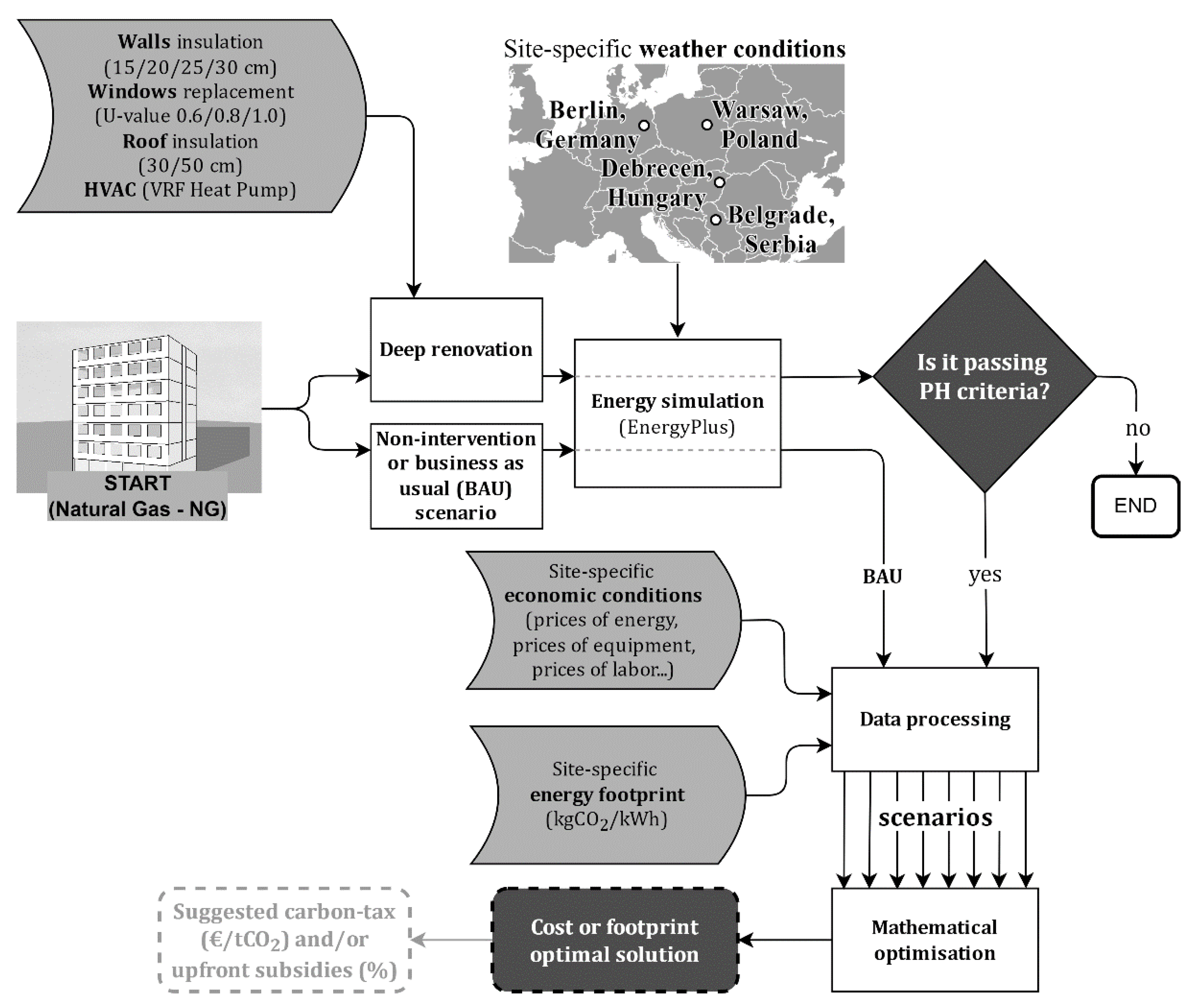

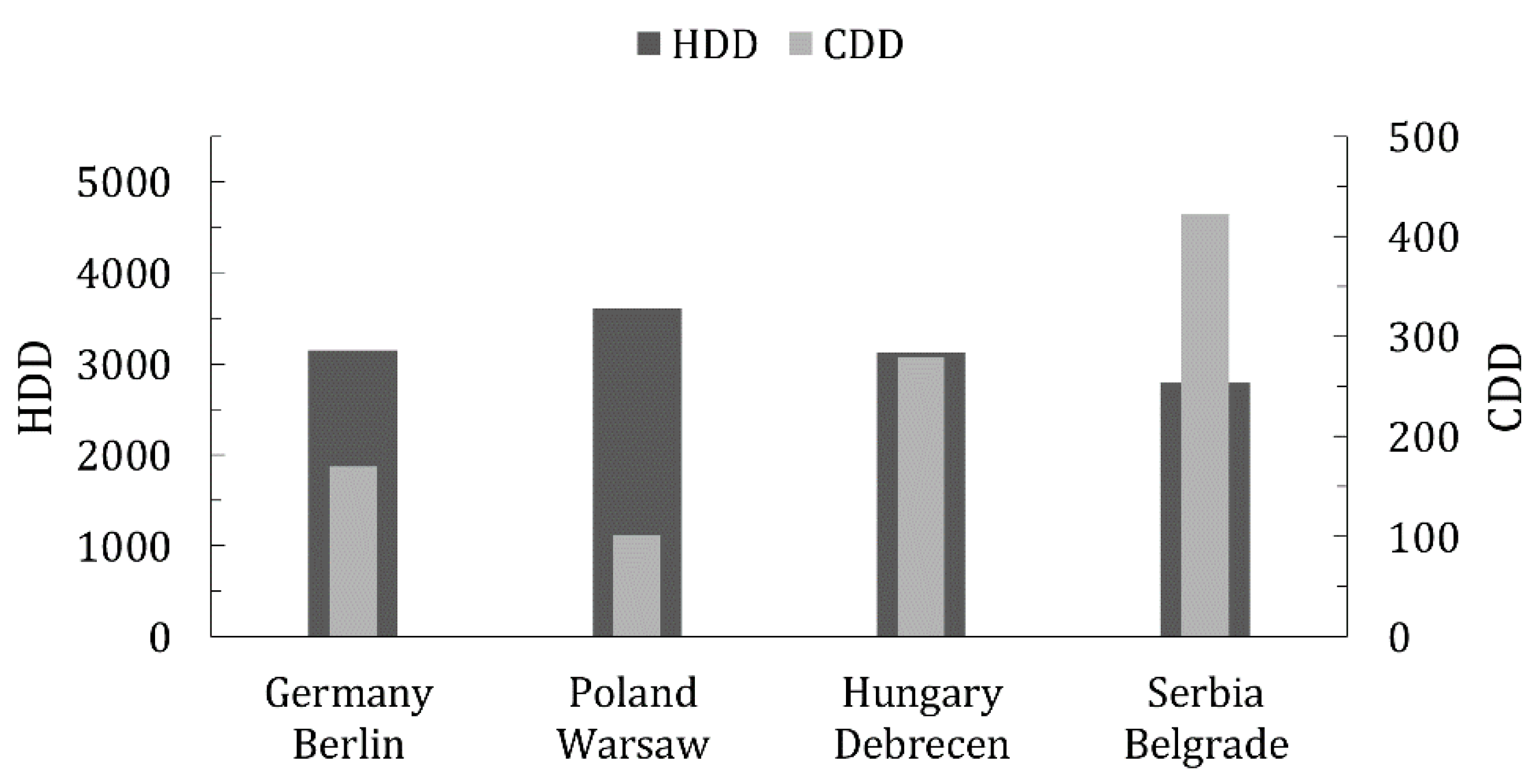

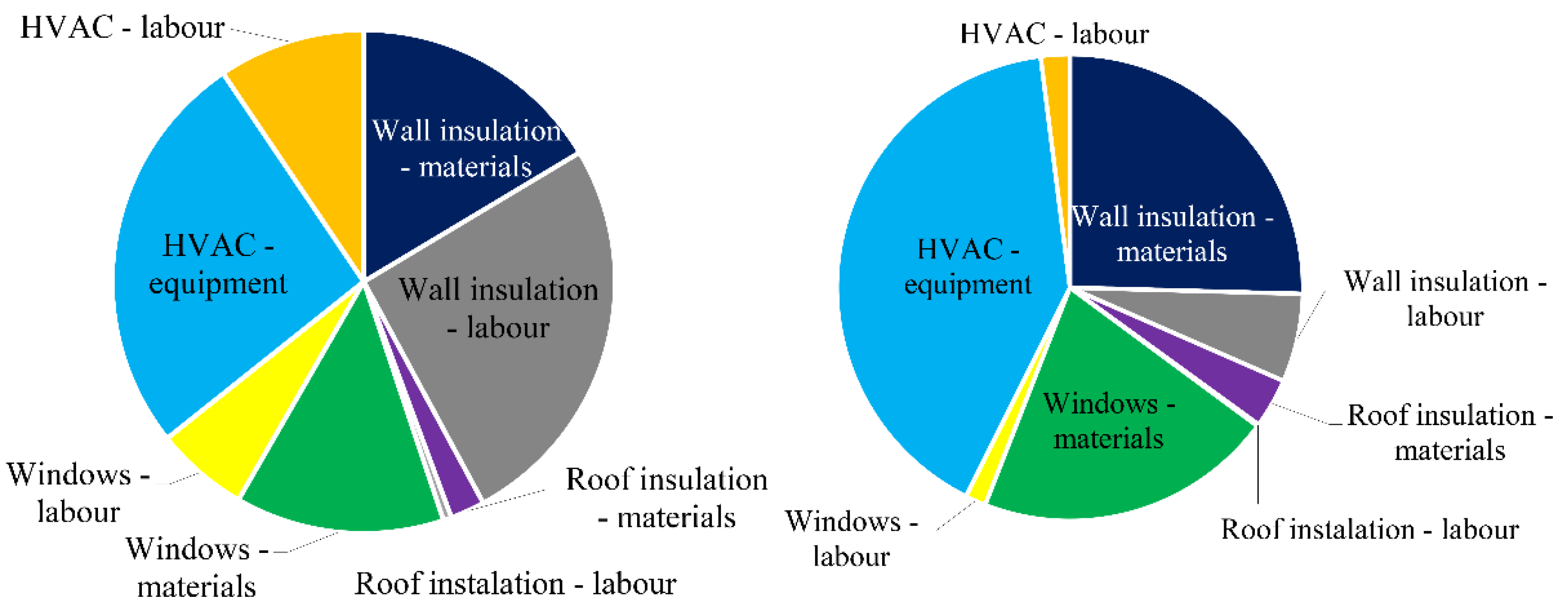
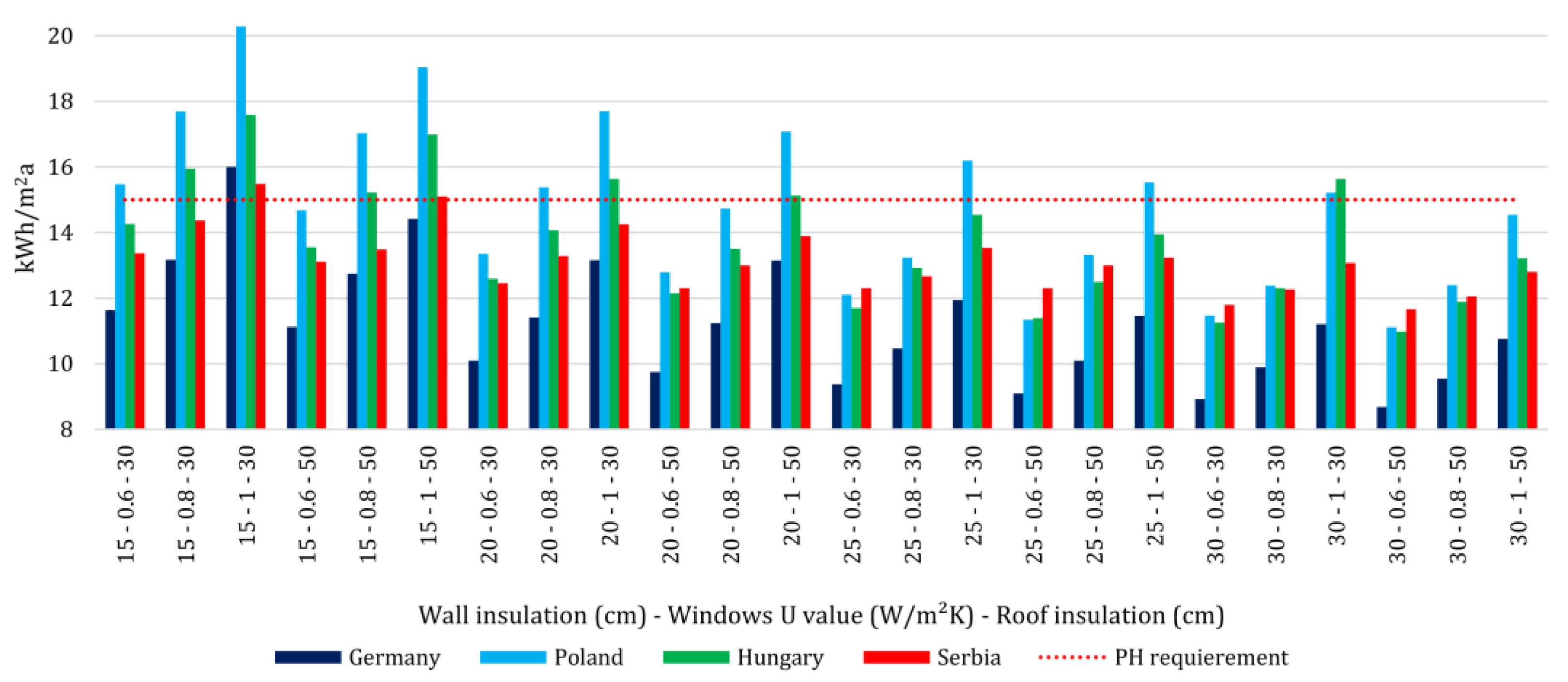
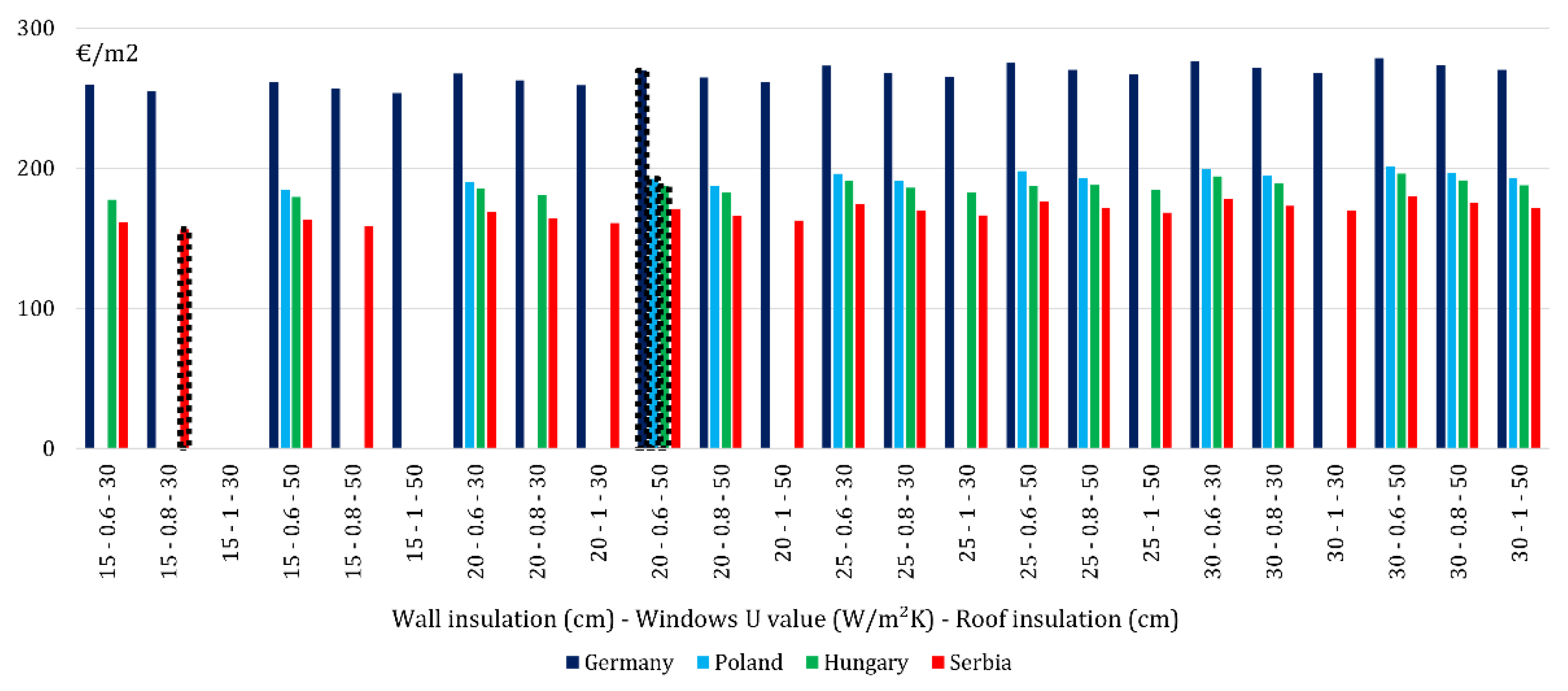
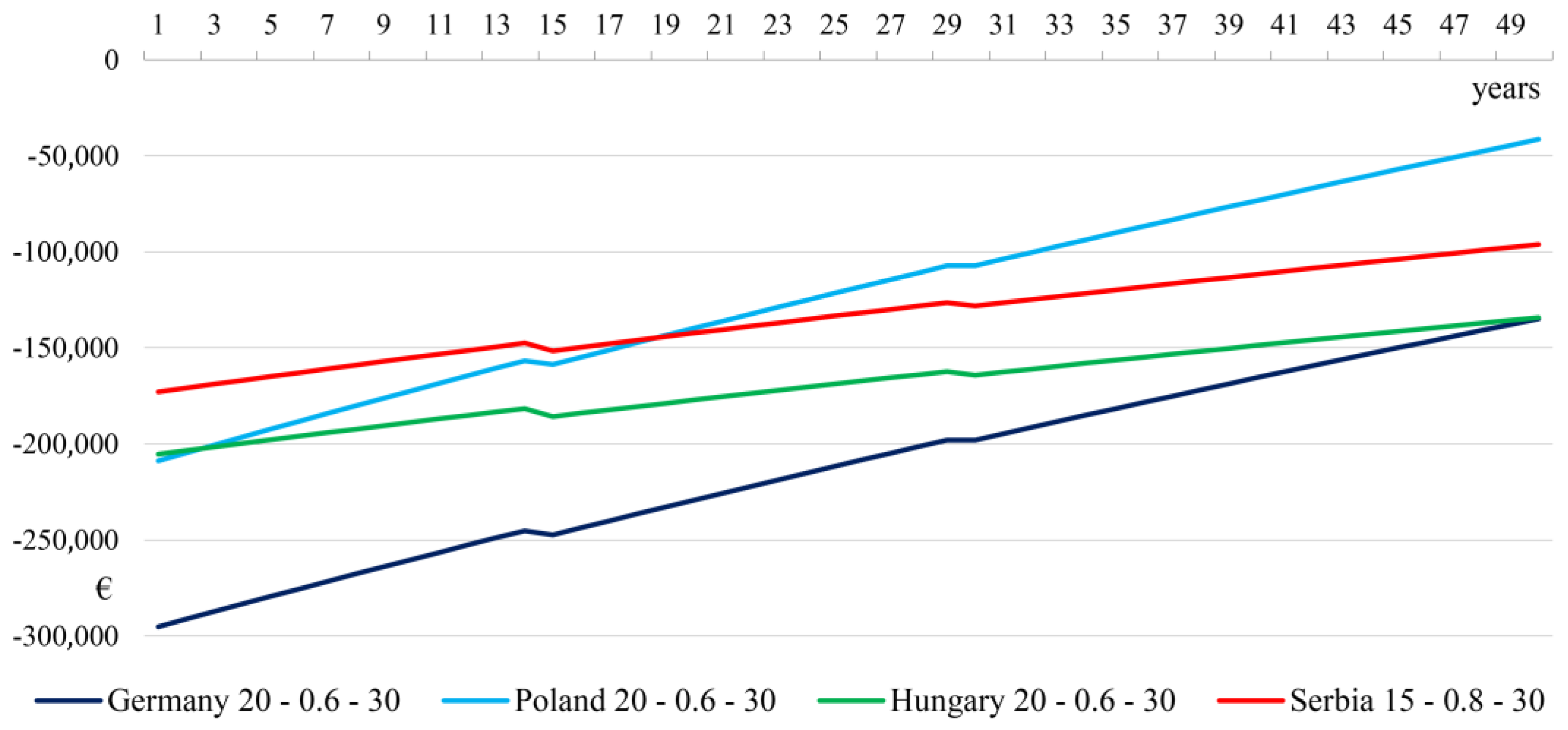

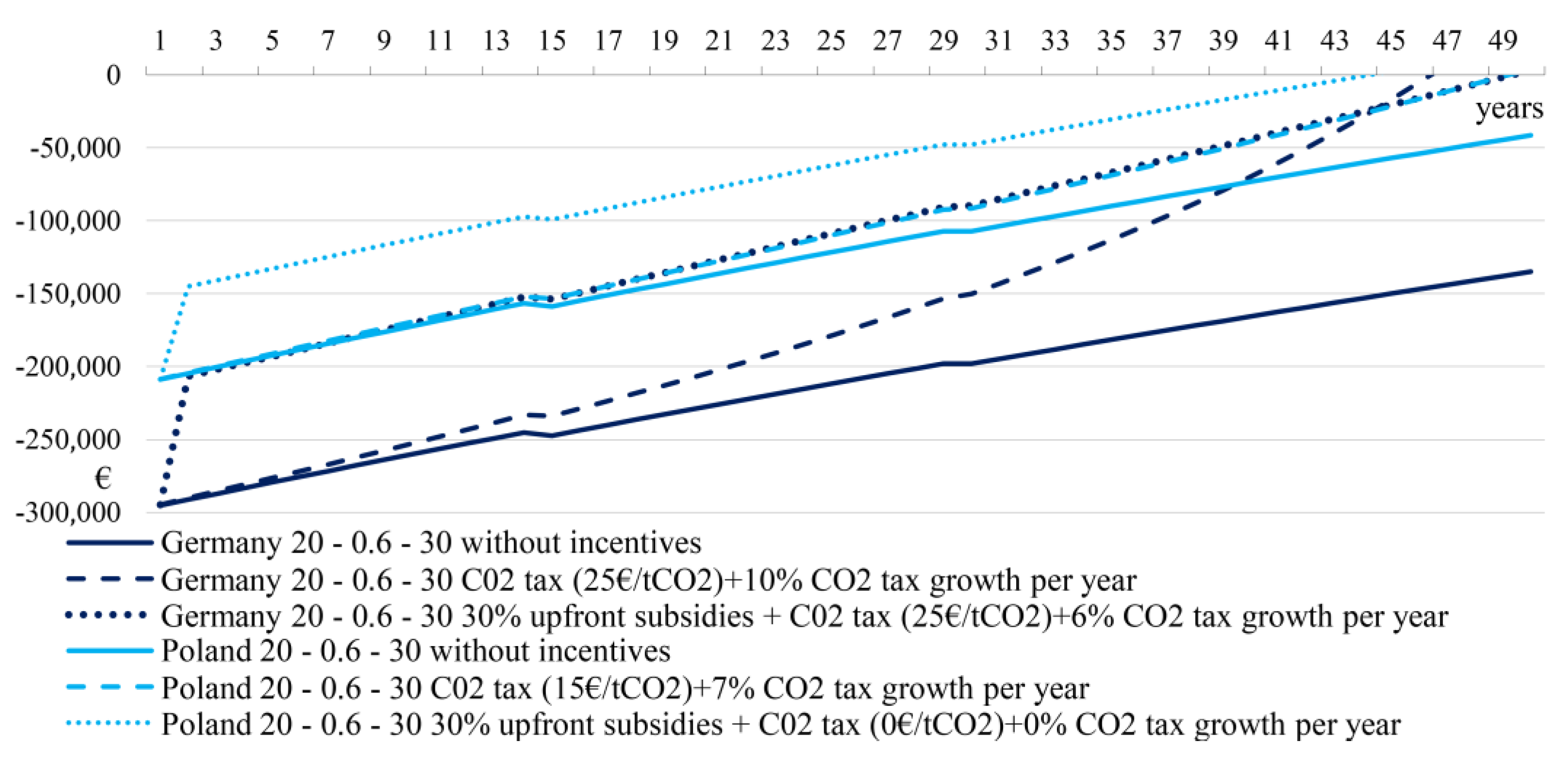
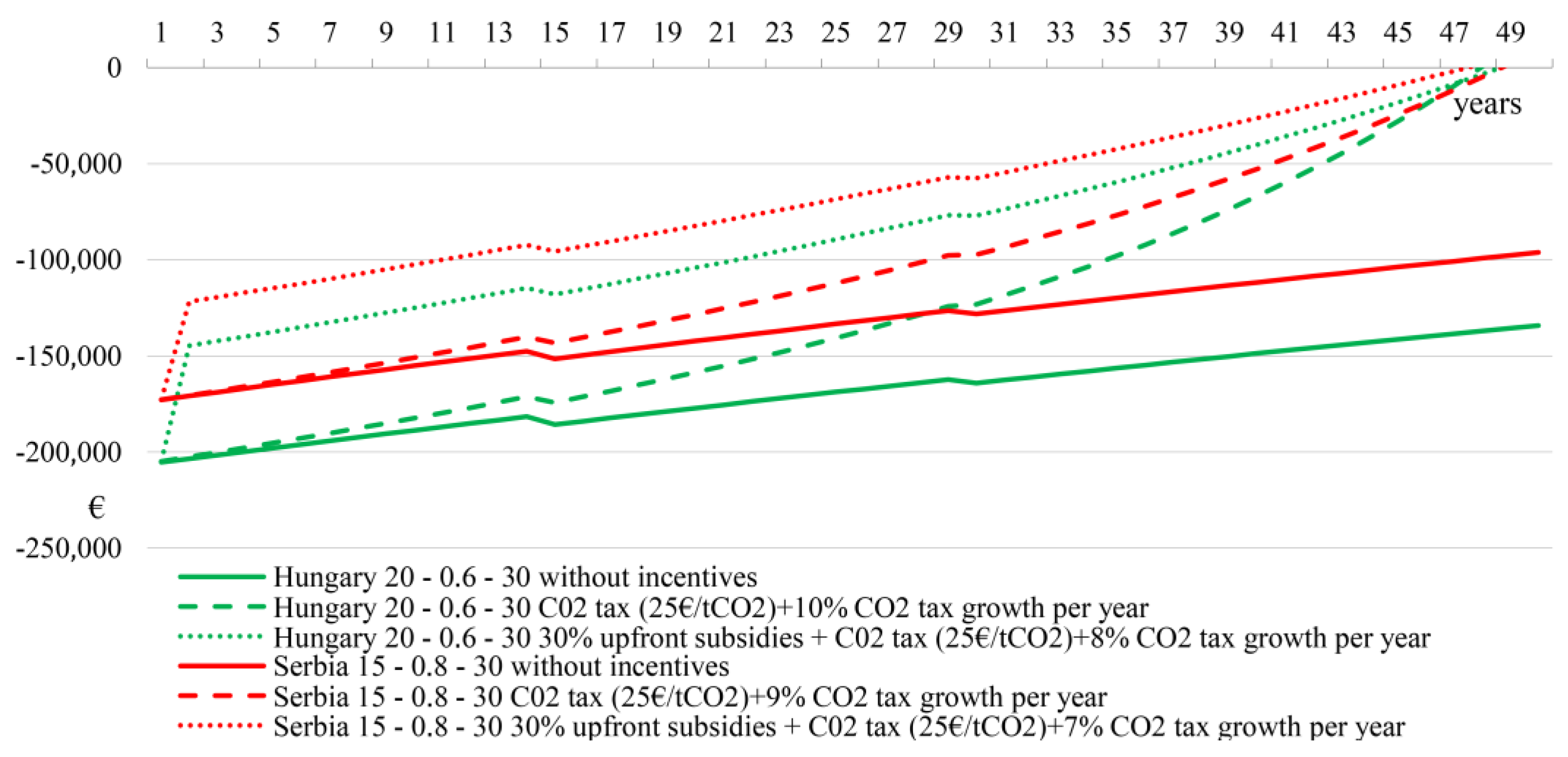
Publisher’s Note: MDPI stays neutral with regard to jurisdictional claims in published maps and institutional affiliations. |
© 2022 by the authors. Licensee MDPI, Basel, Switzerland. This article is an open access article distributed under the terms and conditions of the Creative Commons Attribution (CC BY) license (https://creativecommons.org/licenses/by/4.0/).
Share and Cite
Končalović, D.; Nikolic, J.; Vukasinovic, V.; Gordić, D.; Živković, D. Possibilities for Deep Renovation in Multi-Apartment Buildings in Different Economic Conditions in Europe. Energies 2022, 15, 2788. https://doi.org/10.3390/en15082788
Končalović D, Nikolic J, Vukasinovic V, Gordić D, Živković D. Possibilities for Deep Renovation in Multi-Apartment Buildings in Different Economic Conditions in Europe. Energies. 2022; 15(8):2788. https://doi.org/10.3390/en15082788
Chicago/Turabian StyleKončalović, Davor, Jelena Nikolic, Vladimir Vukasinovic, Dušan Gordić, and Dubravka Živković. 2022. "Possibilities for Deep Renovation in Multi-Apartment Buildings in Different Economic Conditions in Europe" Energies 15, no. 8: 2788. https://doi.org/10.3390/en15082788
APA StyleKončalović, D., Nikolic, J., Vukasinovic, V., Gordić, D., & Živković, D. (2022). Possibilities for Deep Renovation in Multi-Apartment Buildings in Different Economic Conditions in Europe. Energies, 15(8), 2788. https://doi.org/10.3390/en15082788





